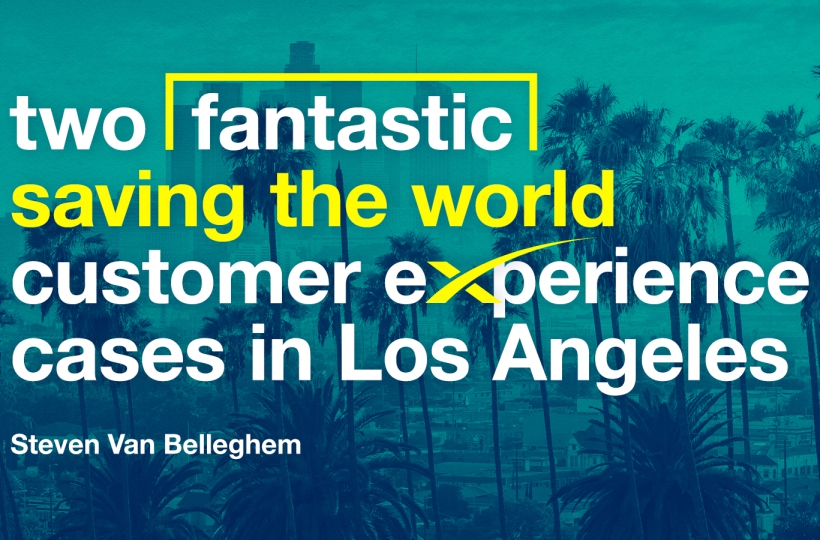Two fantastic “Saving the World” customer experience cases in Los Angeles

SpaceX and Starlink
I want to illustrate the higher purpose of Elon Musk’s Starlink company – probably my top favourite visit in this tour – with a story about their custom-made devices for Ukraine. Walking around in the Starlink factory, we could see that the packages were separated into two piles: one for Ukraine and another for all the other countries. I obviously can’t go into detail about this, but they actually adapt the Starlink devices to better suit the situation in the Ukraine: for instance by making it harder to identify them, for reasons of safety. I’m sure that you will find it very difficult to find another company with the same approach: so extremely dedicated to helping their customers who need it the most but also so fast that they can adapt the production, triage and delivery system to that in a matter of days.
This is just a ‘random’ story in the entire Starlink system, but it’s also a perfect illustration of how mission driven they are, and how that mission ties in to the higher purpose of building solutions that will help humanity progress. Their end goal is a noble one: providing internet access to the 3 billion people in the world who don’t have that for the moment.
Could you be cynical about that because the device costs 499 dollars and the subscription 99 dollars per month and the bulk of those people won’t be able to afford that? You certainly can. But you also need to realize that this is just phase 1 of a well-thought through philosophy and that Elon Musk always works in this order:
- First get the technology right: because you can’t launch hardware in an experimental phase, like you can with software.
- Then make money with the expensive first versions of this new technology – like the Tesla Model S that cost more than 100K dollars – from which they keep learning in order to make them better, more efficient and cheaper.
- Strive for cost reduction so that everyone (well, you know, perhaps not the space rockets…) will be able to afford it. The Tesla Model 3, for instance, is about three times less expensive by now. The same goes for SpaceX: they have been able to reduce the cost of a spaceship with almost 65%, because of their reusability strategy. And if you extrapolate that to Starlink: the end goal is to make internet not just accessible, but also really affordable for everyone.
What I perhaps love most about Musk’s vision for his companies is his radical singlemindedness. Like with SpaceX, every decision is made in terms of their clear Mars-driven strategy: if it helps them colonize Mars and create a species of interplanetary humans, they’ll do it. Otherwise they just won’t, even if it’s a financially interesting deal. I love that combination of an almost obsessively focussed mission with a clear direction of price-optimalisation in order to help build a better world. it is truly impressive.
Everytable
Another company visit that was a clear example of the ‘Saving the world’ strategy as described in my ‘Offer You Can’t Refuse’ book, was Everytable, a company that believes that “nutritious food is a human right”.
They make the world a better place in two ways. First of all, it is their mission to make sure that everyone in the United States can have access to fresh and healthy food that is cheaper than let’s say McDonald’s. We all know that often, the only food that is unfortunately available in less fortunate neighbourhoods is unhealthy but cheap fast food. And the latter creates a negative vicious circle for the people living there because healthy food is crucial for brain and body development or even just for feeling energized and good about yourself. And so Everytable wants to be present in these neighbourhoods to offer salads, fresh food and fresh soups that are cheaper than the price of a big Mac menu in that specific place.
But, second, the really cool thing is that they’re not just providing better food in those neighbourhoods. They also look for and then empower entrepreneurs from less fortunate social backgrounds. And they look for grants or for government support so that they can have enough funds to start an Everytable franchise. And then the rest can be borrowed at a very low interest loan from their own organization. If you don’t realize how special that is, just know that if you want to start a McDonald’s franchise in the US, you need to put at least half a million dollars in cash on the table, and you need another half a million in loans from the bank. So most people who start a McDonald’s franchise are people in their forties who did pretty well in life. But Everytable is completely different: they want to enable diverse entrepreneurship, from people from lower social classes too. And I think that that’s beautiful: they are able to make a profitable business and help others at the same time.
And I really saw a number of this type of companies on our LA tour. It’s fascinating that in a city like LA, where the contrast between the rich and the poor is so big and where you have such an obsession with technology, that you also find that excitement for trying to improve the world. There’s this fantastic can-do mentality and optimism behind it, and I was really delighted to find this Offer You Can’t Refuse dynamic in such an unlikely place.